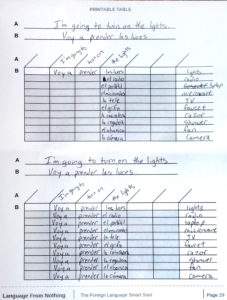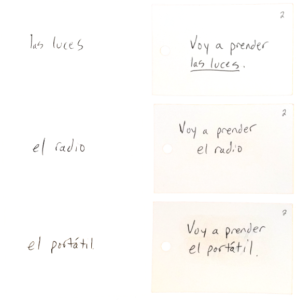Day 02 Phrase – “I’m going to turn on the lights”
Today we will start with our first actual Habitat Language phrase. Habitat language is just that – language I’m using from my own habitat or surroundings.
I am using strategies from my video course called The Foreign Language Smart Start in order to help me start learning my first words and phrases in Spanish. You can check out the introduction to these strategies by watching the video course. It’s completely free – no opt in required. Just go HERE!
These strategies apply to ANY language you are learning, so you don’t have to be learning Spanish to follow along.
Let’s start by refreshing our minds with the phrases we learned last time.
Recall: The 6 Pocket Phrases
The phrases we learned yesterday (Day 01) were called pocket phrases. These phrases are meant to be learned before anything else because they can be used immediately and act as tools to help you learn the language.
| English | Spanish |
| 1. What does this mean? | 1. ¿Qué significa esto? |
| 2. What is this word? | 2. ¿Qué es esta palabra? |
| 3. How do you say ____? | 3. ¿Cómo se dice ____? |
| 4. I don’t know. | 4. No se. |
| 5. I forgot. | 5. Se me ovlidó. |
| 6. I need to look it up. | 6. Debo buscarlo (en el diccionario). |
I will be using these phrases to help me learn Spanish. Every time I see a word I don’t know, I’ll try to say “¿Qué es esta palabra?” or, “¿Qué significa eso?” instead of saying it in English.
Day 02 Phrase – “I’m going to turn on the lights”
Following my Habitat Language strategy, I chose “lights” as the item in my habitat to build my sentence from. After I chose the item, I created a sentence that would go nicely with it. While reading my language reference of choice, DIY Spanish: Top 12 Tools for Speaking Spanish by Mark Rhea, I came across the phrase:
“I’m going to < do something >”
I can use this to talk about what I’m going to do in the near future, and figured it would be a good phrase to use with lights.
English: I’m going to turn on the lights.
Spanish: Voy a prender las luces.
These are the sentences as they naturally occur in each language. Below is the breakdown of each component of the Spanish sentence. You don’t need to go into great detail or study complicated grammar rules here. This is just to get a general sense of what each component of the sentence means. A component could be one word or a group of words, depending on what you are practicing at the time. Also note that it is important to break down the Spanish sentence in it’s natural word order since the English might be different.
Breakdown:
Voy a = I’m going to
prender = turn on
las luces = the lights
As you can see, I didn’t go into a lot of detail breaking down each component. Simple, to-the-point meaning.
Now let’s find other items to use our sentence with.
Using the sentence with other items
Let’s take our sentence and replace lights with other things we might be able to turn on.
| Voy a prender | las luces | (lights) |
| el radio | (radio) | |
| el portátil | (laptop) | |
| el microondas | (microwave) | |
| la tele | (TV) | |
| la rasuradora | (razor) | |
| el abanico | (fan) | |
| la cámara | (camera) | |
| Voy a abrir | el grifo * | (faucet) |
| Voy a abrir | la ducha * | (shower) |
Printable Table
In order to build my phrase with other items I went around my habitat (in my case this was my house) and and found other things that applied to the sentence – things that can be turned on. I kept track of these by filling out a phrase table you can download and print out from my Guidebook (see sidebar opt-in). Here is what it looks like:

The same phrase is used in both the top and bottom tables in the above picture. This is to show you 2 different ways you can fill them in. One way is to copy the entire sentence down with each new item (bottom table), which is good for practicing your handwriting. Another way is to only write the word that you are replacing (top table), which is my favorite because it’s cleaner and less work!
You can see the main phrase and translations in the middle, then over off to the side you can see the item from my habitat in English. For further instructions on how to fill out the table, download the free Guidebook (see sidebar opt-in).
Practicing with Flashcards
The way I like to practice these phrases is by writing the item on one side of the flashcard and the full sentence on the other, like this:
Side 1 Side 2

Then I mix them up into a pile with the item on Side 1 facing up. I first read the item, then try to say the full sentence before flipping the card over to check the answer. This strategy is derived from Dr. Paul Pimsleur’s book How to Learn a Foreign Language.
Notice there is no English on the flashcards. You want to practice responding to Spanish with Spanish. Side 1 is your Spanish prompt to which you respond with the full Spanish sentence. This is called an Interaction Pattern. Interaction patterns help you get comfortable with giving automatic, natural responses in the foreign language without translating to English (or your native language) first. When you are fluent in a language, thoughts and responses automatically flow off the tongue. Practicing this way helps you get used to giving those automatic responses.
If you forget what a word means, refer back to the phrase table you filled out when building your sentences. Once you’ve refreshed your memory by looking at the English words or phrases in question, go right back to your all-Spanish flashcards and continue practicing your Spanish responses.
Links
How to Learn a Foreign Language
28 Day Spanish Challenge Intro
Day 01 – Pocket Phrases
The Foreign Language Smart Start
